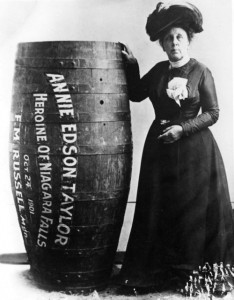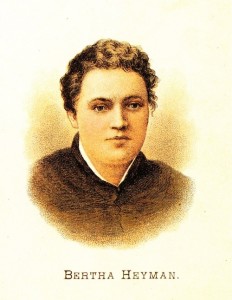As Evel does
by Shawn VestalAmericans love a confident scoundrel. We are willing – some large number of us are, anyway – to forgive myriad flaws, lies and crimes, so long as the offender is charismatic and self-assured.
Perhaps this is true of people everywhere, but there is a particular strain of American rogue that populates the nation’s history to such a degree that it seems to answer a national yearning, a hunger to believe in someone courageous and heedless and free – free from the laws of gravity, society and propriety. We give them our money and attention, and we forgive them their sins. This tendency explains, in part, how the unprepared, overconfident buffoon Donald Trump has gathered political support – his lies, ignorance and bigotry matter less to his supporters than his sheer self-assurance, his confident crashing-through-the-boundaries. For a nation that boasts so relentlessly of its freedom, our inclination to love these rogues reveals a deep national insecurity – a sense that we are bound by limits that must be recklessly breached.
Few people illustrate this better than the 1970s motorcycle jumper Evel Knievel, whose fans consider him the greatest daredevil who ever lived. But it wasn’t Knievel’s daring that set him apart – it was his showmanship, his boldness, his bullshit. (Knievel’s history and persona figure prominently in my new novel, Daredevils.) Knievel jumped cars and buses on his motorcycle all over America – and once at Wembley Stadium – and he failed to jump a canyon in a custom steam-powered rocket. He also made and spent money lavishly, boasted and blustered and bullied people, peddled incredible – and often untrue – tales to the press, was a womaniser and a deadbeat. But when he took to the microphone, wearing red, white and blue outfits and giving advice to America’s children, he acted, and was treated, like a hero.
What follows is an eclectic and disparate list of 10 (mostly) Americans from history who encompassed some of the traits that Knievel so garishly exhibited. Some were mere promoters, some were outright criminals, but all reflected the outsized confidence of a daredevil.
The Salt River Roarer
It’s hard to tell myth from fact in the tale of Mike Fink, a keelboater and expert shot from Pittsburgh in the early 1800s. A charismatic drinker – like so many of this ilk – Fink is said to have shot, from a riverboat, the tails off eight or nine piglets on shore, and he and a pal regularly shot cups of whiskey off each other’s head for entertainment. He spoke like Evel Knievel’s boastful great-grandfather. Several accounts of Fink’s life cite the following, possibly ginned-up, quotation: “I’m a Salt River Roarer! I’m a ring-tailed squealer! I’m a reg’lar screamer from the ol’ Massassip! WHOOP! I’m the very infant that refused his milk before its eyes were open, and called out for a bottle of old Rye! I love the women an’ I’m chockful o’ fight! I’m half wild horse and half cockeyed-alligator and the rest o’ me is crooked snags an’ red hot snappin’ turtle…” He is believed to have been killed after accidently shooting a man in the head, rather than shooting the cup of liquor off his head, while on a fur-hunting expedition in the Rocky Mountains in 1824. His legend became the source for many a tall tale.
The Queen of the Mist
Annie Edson Taylor was less a scoundrel than most on this list, but she was Knievel’s direct matrilineal ancestor in her pursuit of riches through pointless daring. A schoolteacher who was widowed during the Civil War, she tried without success to escape poverty until she decided to try something extreme. On her 63rd birthday in 1901, Taylor climbed into a pickle barrel that had been outfitted with a mattress and leather harnesses and rode over Niagara Falls, surviving with minor injuries. She had sent her cat over two days earlier in a test run. “She never seemed to have any doubt that she would survive,” the official historian of Niagara Falls, Sherman Zavitz, once said. “She was a very determined lady. A very upbeat sort of person. A very positive person. So she was quite certain she could do this stuff, and would survive it, and would make a fair bit of money from it.” The stunt brought her a measure of fame, but it faded quickly and Taylor never earned the fortune she sought. She tried to score off her feat with a series of stage appearances, but lost a key prop: her manager ran off with her barrel. In subsequent years, her feat was often imitated – sometimes with fatal results.
The Goat-Gland Doctor
Medical quackery has been fertile soil for scoundrels. In the early twentieth century, Kansas physician John Brinkley made a fortune implanting goat testicles in men to restore their virility – for $750 a pop. Eventually, Brinkley began claiming the goat balls were a cure for all kinds of things, from depression to flatulence. (Other quacks were doing similar ‘gland work’ at the time, including a doctor in Chicago who was implanting monkey testicles in patients.) The press covered these treatments more or less credulously at first, and Brinkley parlayed it into a political and radio career. Eventually, he was exposed as a quack, but not before he made two unsuccessful runs for governor. The term ‘goat gland’ became a term of art in Hollywood in the late 1920s after the advent of sound in movies, to refer to a silent film that had ‘talkie’ scenes spliced in.

The Eiffel Tower under construction, 1888. Louis-Emile Durandelle/The Getty Center/Wikimedia Commons
The Man Who Sold the Eiffel Tower
Victor Lustig, born in Austria-Hungary in 1890, became one of the most notorious con artists in history. Among his many scams was a masterpiece: he ‘sold’ the Eiffel Tower – not once, but twice. In 1925, the rusting tower was a source of controversy in France, and many people were clamouring for its removal. Lustig forged documents and posed as a government official, and took $70,000 from a scrap metal dealer who thought he had purchased 7,000 tons of scrap. Lustig apparently tried to run the scam a second time, but Parisian authorities caught on and he had to flee – to America. He eventually died in a Missouri prison.
The Fox Sisters
Spiritual and religious hucksters populate human history – to a degree that perhaps depends on the limits of your own faith. But there is no doubt that Leah, Margaret and Kate Fox, a trio of sisters from New York who helped inaugurate the Spiritualism movement in the 1840s, were charlatans, given that one of the sisters eventually confessed as much. The sisters travelled the country performing as mediums, and in their performances, the dead would supposedly answer their questions through a series of ‘rappings’. The truth behind this is scarcely more believable than the scam was: the sisters had figured out a way to produce these noises by cracking their toe knuckles, among other methods. In 1888, Margaret rented a New York stage and made her confession: “I have seen so much miserable deception,” she said. “That is why I am willing to state that Spiritualism is a fraud of the worst description.”
The Promoter
Tex Rickard was a promoter of Barnum-like proportions. Born in Missouri, he got rich in the Klondike gold rush, went broke gambling, and worked as a sheriff and saloon owner in Alaska before landing in the work that would make his name: promoting boxing. Rickard became the promoter for legendary heavyweight Jack Dempsey, and he gained control of Madison Square Garden – a combination that helped him create and make profitable the notion of an arena-sized spectacle. He produced the first million-dollar gates at boxing matches. He reportedly told Dempsey, “Most folks are willing to believe anything you tell ’em. It’s all about how it is presented.”
The Million-Dollar Bunco Artist
Lou Blonger, along with his brother Sam, was a towering figure in the settling of the West. The Blongers – who were once officers of the law – ran saloons, gambling dens, brothels, numbers rackets, gold mines and all manner of other shady enterprises in Denver, Colorado, from the late 1800s to the early 1920s, all while travelling in respectable business and political circles. The Blongers graduated to running a series of elaborate long cons known as the “Million-Dollar Bunco Ring” – setting up false-front stock exchanges and betting parlours to scalp out-of-towners. Blonger died in prison in 1924.
The Confidence Queen
Prussian-born Bertha Heyman became one of the most profilic con artists of the late 1800s, mostly by talking men out of large sums of money. She often pretended to be a wealthy widow, temporarily unable to access her own funds. She told The New York Times that, “I delight in getting into the confidence and pockets of men who think they can’t be ‘skinned.’ It ministers to my intellectual pride.” Perhaps Heyman’s greatest contribution to history was her nickname – Big Bertha – which has since been applied to everything from a German World War II howitzer to a giant boring machine digging a tunnel in Seattle.
The Destroying Angel of Mormondom
Porter Rockwell was a longtime friend and bodyguard of Mormon church leaders Joseph Smith and Brigham Young in the early days of the church. A ‘gun-slinger’ in the Western tradition, he is believed to have killed many men, and was alleged to have done so on the orders of church leaders on more than one occasion. He was accused, but not convicted, of attempting to kill the former governor of Missouri Lilburn Boggs, an outspoken opponent of Mormonism. He is said to have claimed, “I never killed anyone who didn’t need killing.” Rockwell’s violence did not estrange him from the leaders of the church – quite the contrary. Smith once ‘prophesied’ that Rockwell, like the biblical Samson, would always be protected if he never cut his hair. Upon his death, Mormon prophet Joseph Fielding Smith said Rockwell had his “little faults” but that “he has gone to heaven and apostates can go to hell.”
The High-Wire Artist
OK, he’s not American. And he’s not a blowhard. And he’s not someone who has sold himself in the American fashion – you’d have to say that Philip Petit is more artist than rogue. And yet there is an enormously appealing mischief in Petit’s high-wire artistry. His clandestine high-wire performance between the Twin Towers in 1974 was the antithesis of the Knievel-esque American media model. He and his buddies snuck into the towers, strung a tightrope wire between them, and then he walked, bounced, sat and laid on the thing while crowds watched from 1,350 feet below. No hype. No press conferences. No grandiose proclamations. It was roguish, it was mischievous, and it was – unlike so many of the other stunts and escapades that litter the nation’s history – a true thing of beauty.
 Shawn Vestal made his literary debut with the story collection Godforsaken Idaho, which won the 2014 PEN Robert W. Bingham Prize. A graduate of the Eastern Washington University MFA program, his stories have appeared in Tin House, McSweeney’s and other journals. He writes a column for The Spokesman-Review in Spokane, Washington, where he lives with his wife and son. Daredevils, his first novel, is published in the UK by ONE. Read more.
Shawn Vestal made his literary debut with the story collection Godforsaken Idaho, which won the 2014 PEN Robert W. Bingham Prize. A graduate of the Eastern Washington University MFA program, his stories have appeared in Tin House, McSweeney’s and other journals. He writes a column for The Spokesman-Review in Spokane, Washington, where he lives with his wife and son. Daredevils, his first novel, is published in the UK by ONE. Read more.
shawnvestal.com




